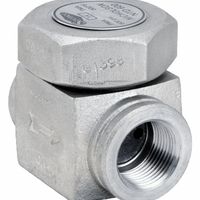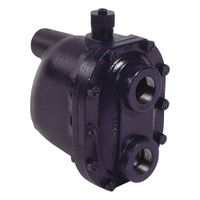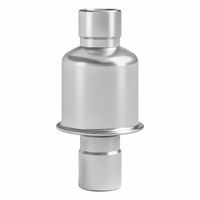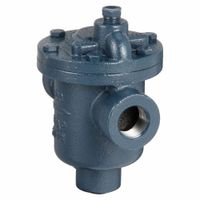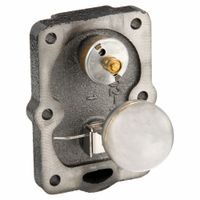Call +(254) 703 030 000 / 751 483 999 / 721 704 777
.....Read More
Frequently Asked Questions
What is the purpose of a steam trap in a hydronic heating system?
The purpose of a steam trap in a hydronic heating system is to efficiently manage the removal of condensate, air, and non-condensable gases from the steam system while preventing the loss of live steam. Steam traps are crucial for maintaining the efficiency and effectiveness of the heating system. They ensure that steam, which is used as a heat transfer medium, remains in its gaseous state until it has transferred its heat energy to the desired location.
When steam releases its heat, it condenses into water, known as condensate. If not removed, this condensate can cause water hammer, reduce heat transfer efficiency, and lead to corrosion and damage to the system. Steam traps automatically discharge this condensate from the system, allowing the steam to continue flowing and providing heat where needed.
Additionally, steam traps help in removing air and non-condensable gases that can accumulate in the system. These gases can form insulating layers on heat transfer surfaces, reducing the system's efficiency. By venting these gases, steam traps ensure optimal heat transfer and system performance.
In summary, steam traps are essential for maintaining the operational efficiency, safety, and longevity of a hydronic heating system by ensuring the proper removal of condensate and gases while conserving steam.
How do inverted bucket steam traps work?
Inverted bucket steam traps operate using a simple mechanical principle to separate condensate from steam in a steam system. The trap consists of an inverted bucket attached to a lever and a valve mechanism within a body that connects to the steam line.
When steam enters the trap, it fills the bucket, causing it to float. As the bucket rises, it pulls the lever, which closes the valve, preventing steam from escaping. The steam inside the bucket eventually condenses into water, causing the bucket to lose buoyancy and sink. As the bucket sinks, the lever opens the valve, allowing the accumulated condensate to be discharged from the trap.
The cycle repeats as steam re-enters the trap, refilling the bucket and causing it to float again, closing the valve. This process ensures that only condensate is expelled while retaining steam within the system, maintaining efficiency and preventing energy loss.
Inverted bucket steam traps are robust and can handle dirt and debris due to their simple design. They are suitable for high-pressure and high-temperature applications. However, they require a certain amount of condensate to function properly and may not be as responsive to rapid load changes compared to other types of steam traps.
What are the advantages of float and thermostatic steam traps?
Float and thermostatic steam traps offer several advantages:
1. **Efficient Condensate Removal**: They provide continuous drainage of condensate, which helps maintain system efficiency and prevents water hammer and corrosion.
2. **Automatic Air Venting**: The thermostatic element allows for automatic air venting, which is crucial during startup to prevent air binding and ensure efficient heat transfer.
3. **Energy Efficiency**: By effectively removing condensate and air, these traps help maintain optimal steam temperature and pressure, reducing energy consumption.
4. **Versatility**: Suitable for a wide range of applications, including heating, process, and tracing systems, due to their ability to handle varying loads and pressures.
5. **Durability**: Constructed with robust materials, they offer long service life and reliability, reducing maintenance costs and downtime.
6. **Self-Adjusting**: The float mechanism adjusts automatically to varying condensate loads, ensuring consistent performance without manual intervention.
7. **Minimal Steam Loss**: Designed to minimize steam loss, which enhances overall system efficiency and reduces operational costs.
8. **Non-Return Valve Functionality**: Some models include a built-in non-return valve, preventing backflow and ensuring system integrity.
9. **Wide Pressure Range**: Capable of operating efficiently across a broad range of pressures, making them suitable for diverse industrial applications.
10. **Ease of Maintenance**: Simple design allows for easy inspection and maintenance, facilitating quick repairs and reducing downtime.
11. **Corrosion Resistance**: Often made from corrosion-resistant materials, they withstand harsh environments and extend the lifespan of the system.
12. **No Priming Required**: Unlike some other types of traps, they do not require priming, simplifying installation and operation.
How do thermodynamic steam traps differ from other types?
Thermodynamic steam traps differ from other types primarily in their operation, design, and application. They use the principles of thermodynamics to distinguish between steam and condensate. The key component is a disc that moves based on pressure and temperature changes. When steam enters, the high velocity and pressure cause the disc to close, trapping the steam. As the steam cools and condenses, the pressure drops, allowing the disc to lift and discharge the condensate.
In contrast, mechanical steam traps, like float and thermostatic traps, rely on mechanical movement. Float traps use a float that rises and falls with the condensate level, opening and closing a valve. Thermostatic traps use temperature-sensitive elements that expand or contract to open or close the trap.
Thermodynamic traps are compact, simple, and robust, making them suitable for high-pressure and high-temperature applications. They are less sensitive to water hammer and can handle superheated steam. However, they may not be as efficient in low-pressure systems and can be affected by environmental conditions like wind or rain, which can cause the disc to flutter.
Other types, like thermostatic traps, are better for low-pressure applications and can adjust to varying loads, while mechanical traps are effective in systems with fluctuating condensate loads. Each type has its advantages and limitations, making the choice dependent on specific system requirements.
What are common signs of a failing steam trap?
Common signs of a failing steam trap include:
1. **Leaking Steam**: Visible steam leakage from the trap indicates that it is not closing properly, leading to energy loss and inefficiency.
2. **Waterlogging**: If the trap fails to discharge condensate, it can cause waterlogging in the steam system, leading to water hammer, corrosion, and reduced heat transfer efficiency.
3. **Noisy Operation**: Unusual noises such as banging or rattling can indicate water hammer or mechanical failure within the trap.
4. **Cold Trap**: A trap that remains cold to the touch may not be functioning correctly, as it should be warm if steam is passing through.
5. **Excessive Cycling**: Frequent opening and closing of the trap can indicate wear or improper sizing, leading to premature failure.
6. **Increased Energy Consumption**: A failing trap can cause increased fuel consumption due to steam loss or inefficient heat transfer.
7. **Back Pressure Issues**: If the trap is not discharging properly, it can create back pressure, affecting the performance of upstream equipment.
8. **Corrosion and Wear**: Visible signs of corrosion or wear on the trap can indicate internal damage, leading to failure.
9. **Erratic Temperature Readings**: Inconsistent temperature readings at the trap outlet can suggest improper operation or blockage.
10. **Reduced System Performance**: Overall reduction in system efficiency, such as slower heating times or reduced output, can be a sign of trap failure.
Regular maintenance and monitoring are essential to identify and address these issues promptly to ensure efficient steam system operation.
How often should steam traps be inspected or maintained?
Steam traps should be inspected and maintained at least once a year. However, the frequency can vary based on several factors such as the type of steam system, the criticality of the application, the type of steam trap, and the operating conditions. In high-pressure or critical systems, more frequent inspections, such as quarterly or biannually, may be necessary. Regular maintenance helps in identifying and rectifying issues like blockages, leaks, or failures, ensuring efficient operation and energy savings.
What are the benefits of using steam trap repair kits and accessories?
Using steam trap repair kits and accessories offers several benefits:
1. **Cost-Effectiveness**: Repair kits are generally more affordable than replacing entire steam traps. They allow for the replacement of only the worn-out components, reducing overall maintenance costs.
2. **Extended Equipment Life**: Regular maintenance using repair kits can extend the lifespan of steam traps by ensuring they operate efficiently and effectively, preventing premature failure.
3. **Energy Efficiency**: Properly functioning steam traps prevent steam leaks, which can lead to significant energy savings. Repair kits help maintain optimal performance, reducing energy waste.
4. **Reduced Downtime**: Repair kits enable quick and efficient repairs, minimizing system downtime. This ensures continuous operation and productivity in industrial processes.
5. **Environmental Benefits**: By maintaining steam traps in good condition, repair kits help reduce emissions and energy consumption, contributing to a smaller carbon footprint.
6. **Improved System Performance**: Well-maintained steam traps ensure that steam systems operate at peak efficiency, improving overall system performance and reliability.
7. **Safety**: Properly functioning steam traps reduce the risk of accidents and equipment damage caused by steam leaks or pressure build-up, enhancing workplace safety.
8. **Convenience**: Repair kits are often designed for easy installation, allowing maintenance personnel to perform repairs without specialized tools or extensive training.
9. **Inventory Management**: Stocking repair kits instead of complete steam traps reduces inventory space and costs, as kits are smaller and less expensive to store.
10. **Customization**: Repair kits can be tailored to specific steam trap models and applications, ensuring compatibility and optimal performance.
Overall, steam trap repair kits and accessories provide a practical, efficient, and economical solution for maintaining steam systems.
